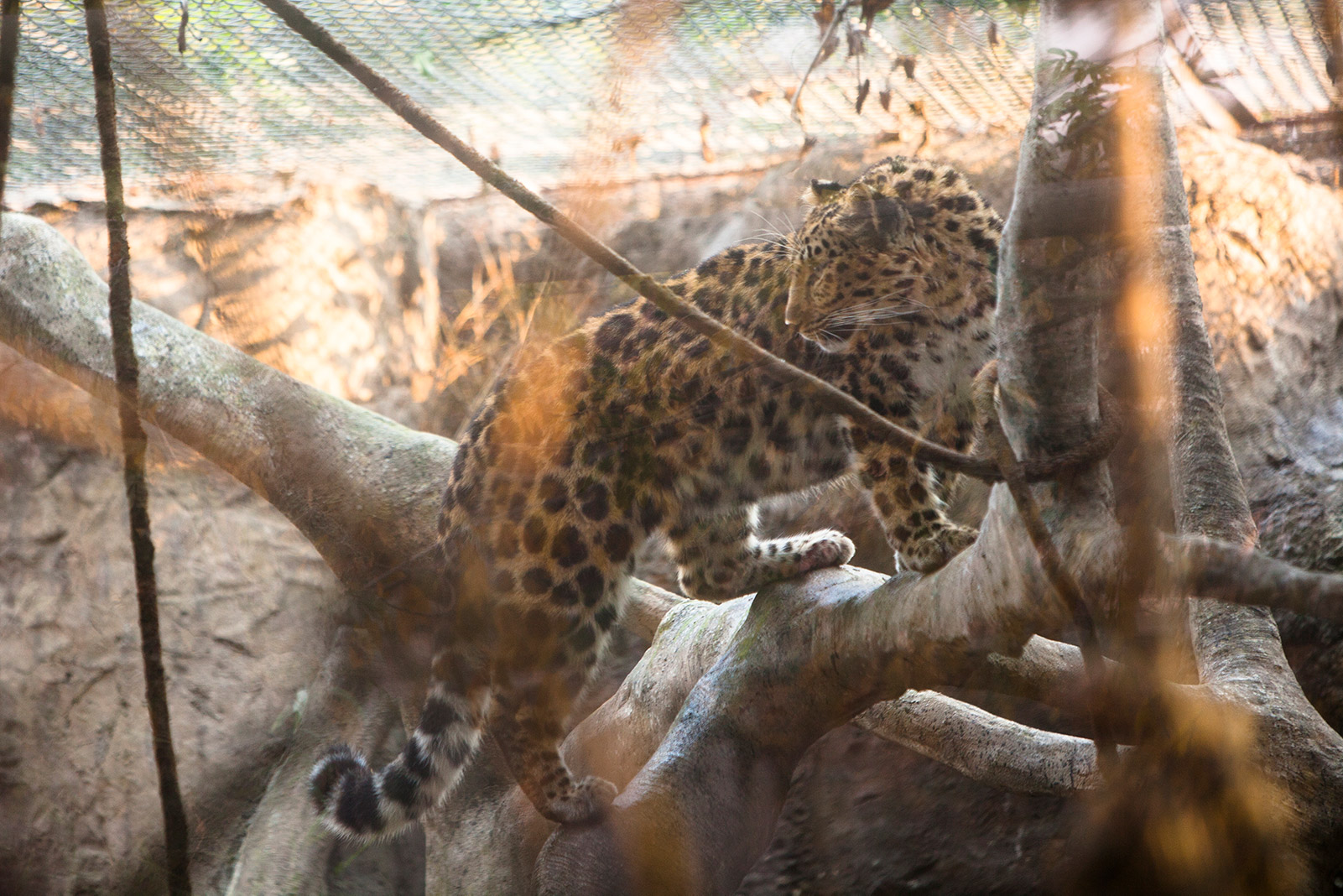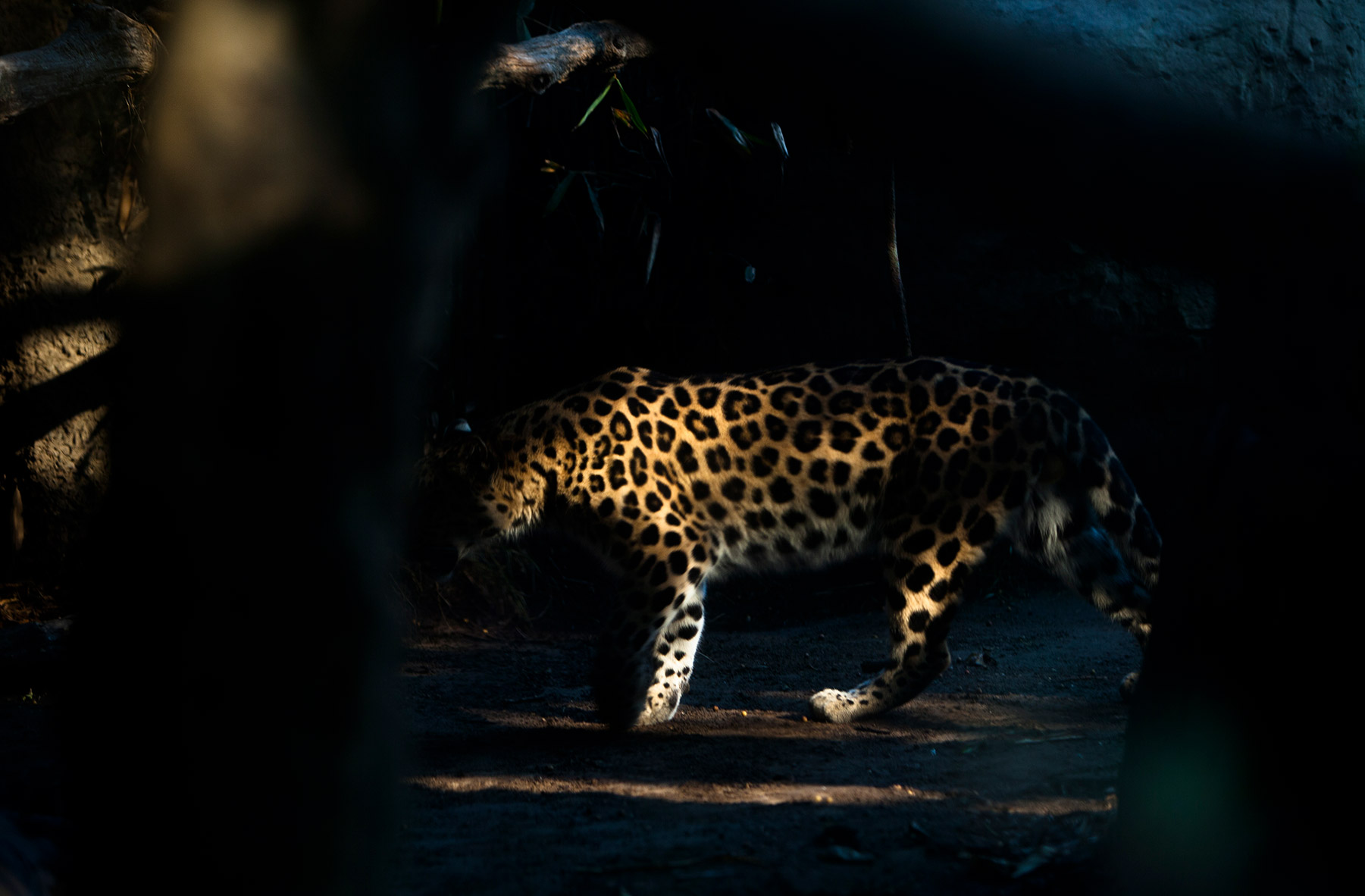
Wyatt leapt gracefully onto the fallen log, his large paws spreading out as he steadied himself on the rounded wooden surface, in search of clumps of wet cat food placed throughout his enclosure. His cream-colored, spotted fur glistened in the diffused sunlight as he found and then gobbled up the treats. Wyatt is a 5-year-old Amur leopard born at the Denver Zoo in April 2012 and raised at the Santa Barbara Zoo, where he arrived the following year. And little does he know it, but he is playing a crucial role in the survival of his species.
Amur leopards are a subspecies belonging to the Panthera (a k a “big cats”) genus, which includes lions, panthers, jaguars, tigers, and leopards. They have the distinction of being not only the most endangered leopards on the planet, but their sparse population means the big cats are also most at risk of extinction. Yet despite their catastrophic categorization, most people have never heard of Amur leopards, let alone know that they are in real danger of being snuffed out. Fortunately, Santa Barbarans are in a unique position to not only learn about Amur leopards but also see them in all of their furry glory at the city’s zoo.
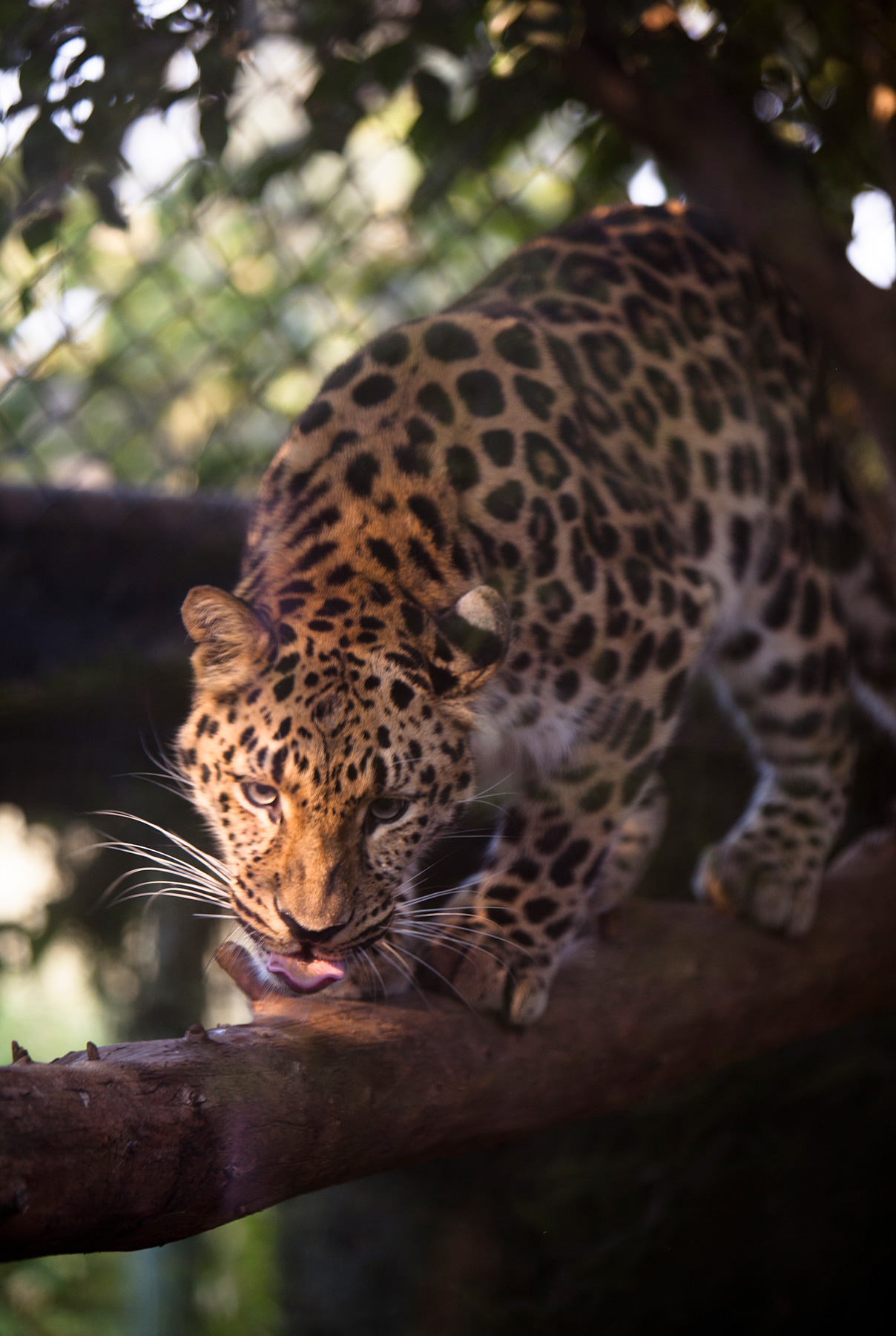
The S.B. Zoo obtained its first Amur leopards in 1993 when conservationists had just begun working with the Species Survival Plan Program through the Association of Zoos and Aquariums (AZA). The Santa Barbara Zoo was one of the few facilities that had the appropriate space available to accommodate big cats at that time. When S.B. Zoo CEO Rich Block took over operations in 1998, it was decided that the city’s zoo would take a more active role in both the captive breeding program and the fieldwork needed to reintroduce the species into its native habitat.
Currently Wyatt lives with a female Amur named Ajax, sent over as a potential mate from Marwell Zoo in Hampshire, England, a little more than a year ago. The hope is that Wyatt and Ajax will have a healthy litter of cubs to carry on a genetically viable line of Amur leopards. The ultimate goal of the breeding program is to repopulate their native habitat with cubs of zoo-born parents.
The Land of Amur Leopards
Stretching more than 2,700 miles, the Amur River is the 10th longest in the world. Its waters wend their way through valleys and rocky canyons, creating the border between southeastern Russia and northeastern China. In this alluvial oasis of rich soil and boreal forest, the Amur leopards made their home for centuries. Living deep in inaccessible reaches of the forest away from humans, they were only recognized as a leopard subspecies in 1857 by German ornithologist/herpetologist Hermann Schlegel. With plenty of prey and the cloaked safety of the impenetrable woodland, the Amur leopard thrived with numbers in the thousands.

In the 1950s, however, the tide turned for the majestic, solitary cats. Recently invented heavy equipment allowed logging and timber industries to begin harvesting trees at a massive rate. As the forests receded, agricultural and mining operations appeared, as did poachers who found it easier to hunt, kill, and sell the animals’ pelts and bones on the black market. By the 1970s, their formerly vast habitat — which once reached all the way into South Korea — was divided into three separate fragments that could scarcely sustain a viable population of the big cats.
As if the outside threats to the Amur leopard weren’t enough, the reduced population forced the animals to begin inbreeding — a pattern that would ultimately destroy their genetic makeup. By the mid-1980s, wild Amur leopards were at critically low numbers — roughly 30 — and it was clear the species would go the way of the dodo unless a major international conservation effort was mounted.
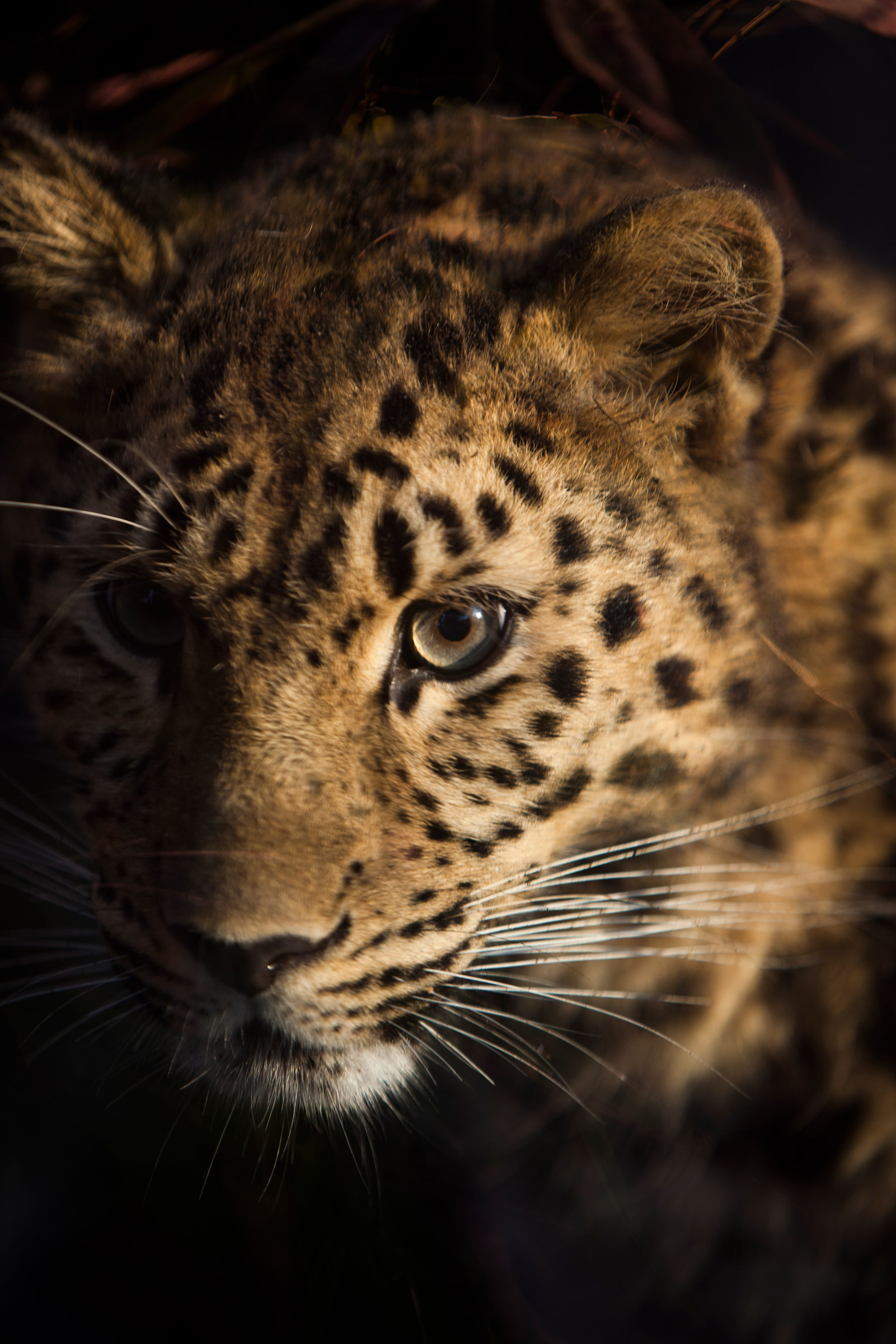
According to the Amur Leopard and Tiger Alliance (ALTA), which formed with the express mission of saving the leopards (and their feline brethren who share the same habitat, the Amur tiger — a k a the Siberian tiger), the “Amur leopard is probably the only large cat for which a reintroduction program using zoo stock is considered a necessary conservation action.” To that end, in the 1990s AZA zoos began educating the public on the Amur leopards’ plight and the established breeding programs that were working to keep a genetically healthy population. Currently, there are approximately 200 Amur leopards in European and North American zoo breeding programs, of which Santa Barbara is one.
Considering their tenuous existence, why, one wonders, aren’t more folks aware of Amur leopards’ dire circumstances? One explanation may be that because leopards are the most widely distributed of the big cats, they give the illusion of existing in plentiful numbers. Also, most people are unable to distinguish between leopard subspecies, of which there are eight recognized today: African, Indian, Javan, Arabian, Anatolian, Indochinese, Sri Lankan, and Amur.
The truth is, all leopards are on the endangered species list, some ranking vulnerable some critical, with the Amur leopards being the most threatened as they are the only ones whose numbers in the wild hover at two digits. And while a global resurrection effort is underway, unfortunately it can take decades for conservationists to undo the damage caused by human incursions. For example, although zoos instituted Amur leopard breeding programs in the early 1990s, the concrete plan to reestablish the cats into their native habitat only came into fruition in 2017.
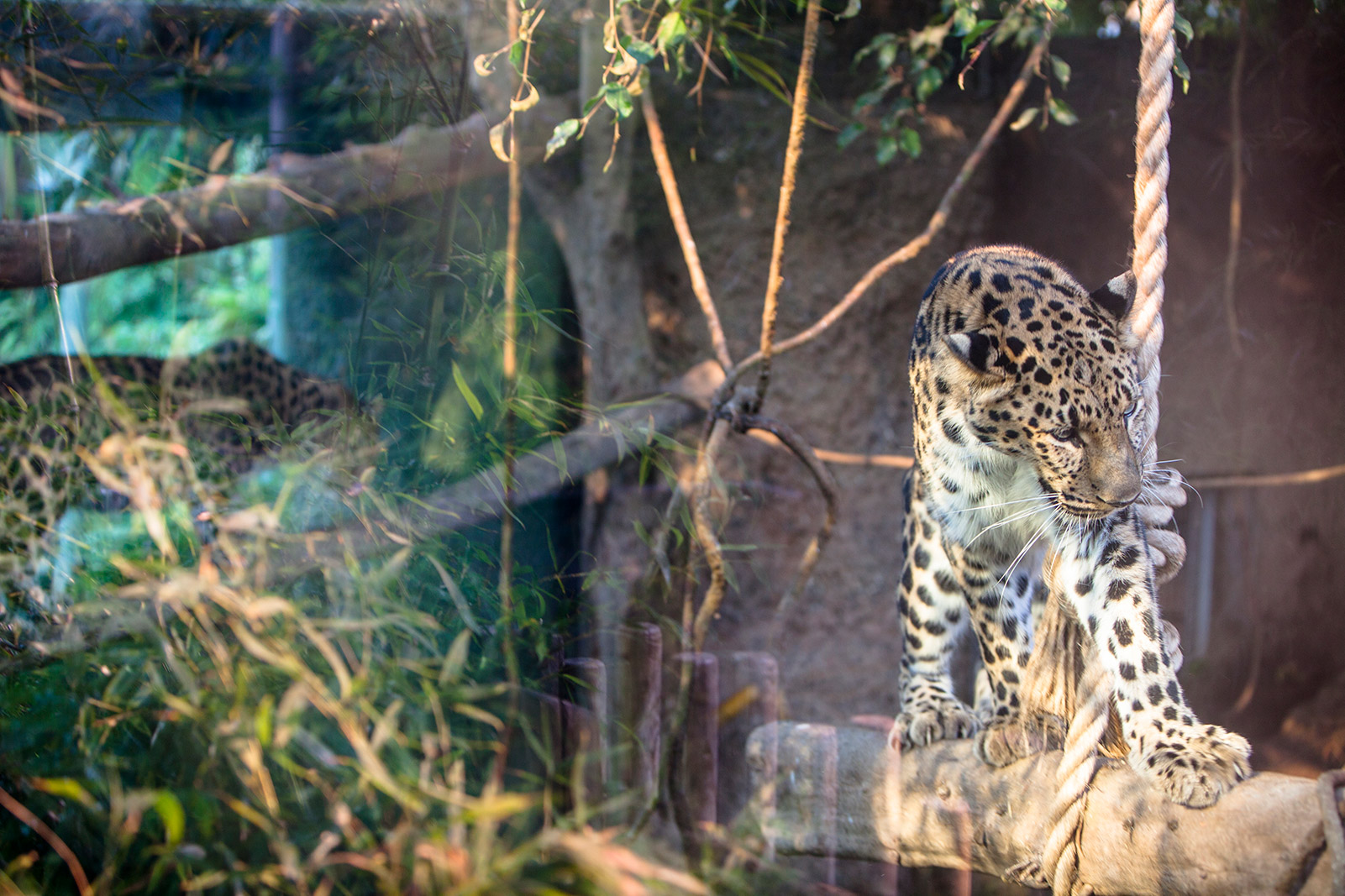
Propagation is occurring in the Lazovsky Nature Reserve, a 467-square-mile area established in 1957 in the southern Sikhote-Alin mountain range in Russia’s Primorsky Krai, near where the remaining handful of Amur leopards roam. The preserve was chosen because it had all the necessary requirements for introducing the cubs into the wild: It is 95 percent forested, there are no Amur leopards currently living there, it is a restricted ecological preserve with humans only allowed to enter for environmental education purposes, and there is an abundance of sika deer, one of the leopards’ main food sources.
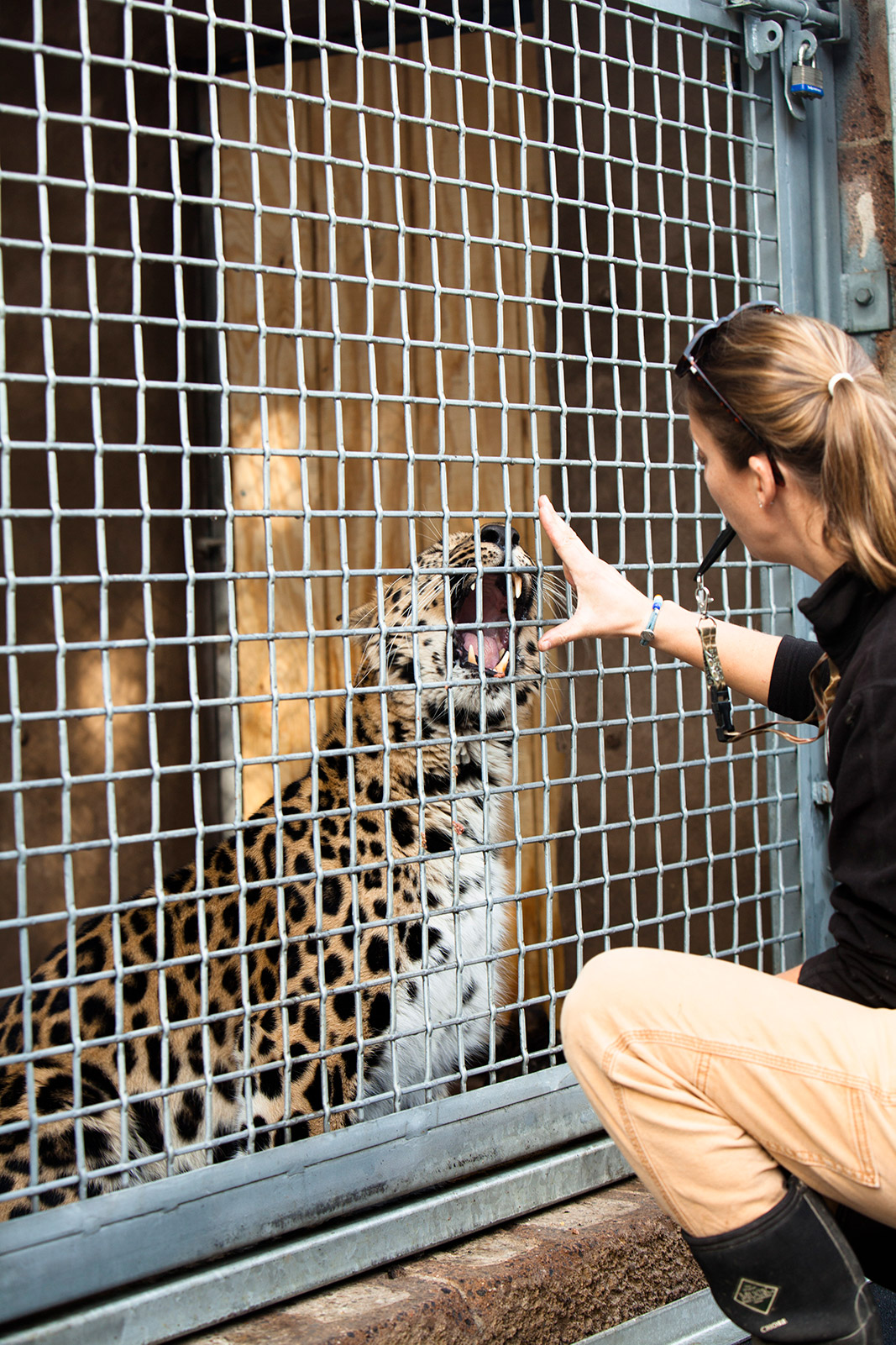
Here’s how the reintroduction process works: Two separate fenced areas, each more than 380 feet long (width depends on the terrain), have been created in the Lazovsky preserve, each one housing a pair of breeding Amur leopards, according to Sandra Markle, author of the fact-filled book The Great Leopard Rescue: Saving the Amur Leopard. Within the enclosure — shaped like a figure eight to allow for a big cat to be removed, such as the male Amur leopard after mating — the feline family has everything it needs to flourish, including water sources and prey. Mama leopard then rears her young in this controlled “wild” land, teaching her offspring to hunt — instinctual skills that zoo-bred leopards retain. At approximately 2 years old, the cubs will be ready to venture off on their own, and at that point they will be collared (so scientists can track them) and released through a gate that leads into the preserve, where they will then go their separate ways in search of territory and mates. Mom will then be returned to her zoo home.
If all goes well, ALTA — which comprises 15 international NGOs that channel money raised by the global zoo community, public, and corporate sponsors to four implementing agencies working to save the Amur leopard, the Zoological Society of London, Wildlife Conservation Society, Phoenix Fund, and Wildlife Vets International — predicts that the wild population of Amur leopards will reach approximately 90 animals in 15 to 20 years. “We hope a second population of at least 30 animals will also have been established by that time,” ALTA reports.
A Leopard Love Story
Thousands of miles from the Lazovsky Nature Reserve, Wyatt and Ajax’s relationship is playing out like a measured Victorian courtship. The process of finding suitable mates is akin to an arranged marriage, except rather than being concerned with how the pairing will further alliances or shore up family names, it is based on whose genetics will best promote the health of the species. Once Ajax was deemed an acceptable DNA fit, it took two years of machinations to get her to town, said Michele Greene, the S.B. Zoo’s head mammal curator.
Ajax arrived in August 2016 and spent a month in quarantine and then several months more familiarizing herself with her new home before she and Wyatt had any introductions. The first time the two cats saw each other was on February 8, 2017, and for that meeting there was plexiglass between them; for two months more, their only contact was eyeballing each other through said glass. Then, on April 12, the plexiglass was replaced with mesh, which remained until September 15, the date they were finally allowed to be in the same room (i.e., full contact in their holdings). Once it was clear Ajax and Wyatt weren’t antagonistic toward each other, things progressed more quickly. By September 27, the two were sharing their enclosure during the day, and as of October 30, after more than a year of prim “dates,” the leopards were finally alone together for 24 hours. Although a significant step, it’s still no guarantee the two will mate. “They might not breed for a couple of years; we just don’t know,” said Senior Mammal Keeper Kristen Wieners, who works closely with the pair. “It’s one of those things where patience is definitely key.”
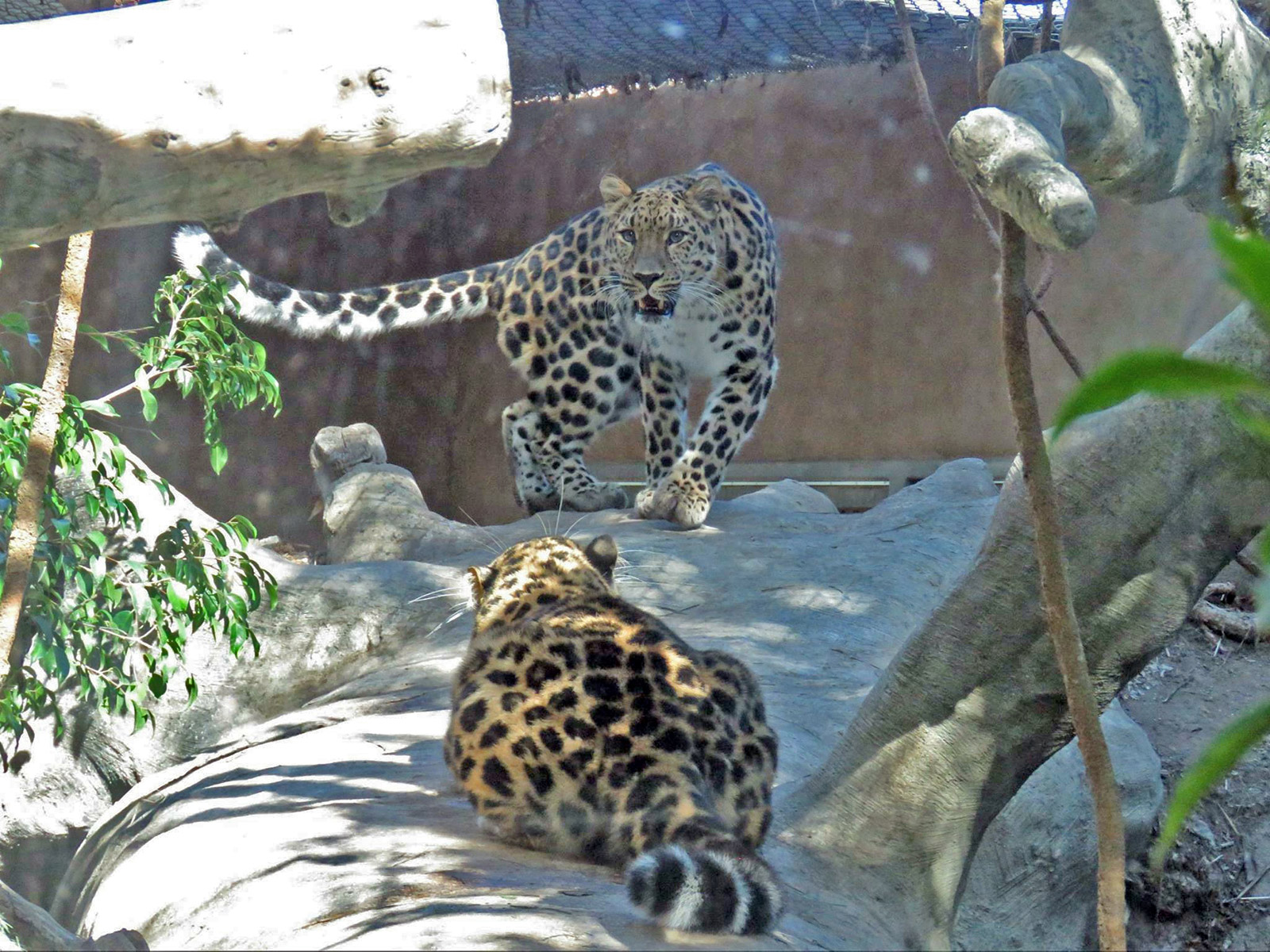
And if Ajax and Wyatt do have cubs, how will they factor into the reintroduction program in Russia? Basically, the role of the Santa Barbara Zoo’s Amur ambassadors is to “vary up the genetics in the North America population,” explained Wieners, so that the species stays viable and healthy. As for relocating to the Far East, “chances are they are going to use mostly European and Russians cats for reintroduction,” she said, “but that doesn’t mean that generations down the line, Ajax and Wyatt’s offspring — if we’re lucky enough to have any — won’t be released. It’s all based on scientists saying we need these genetics for this population.”
Meanwhile, Ajax and Wyatt spend their days courting, patrolling the border of their territory, and working out puzzles presented to keep them intellectually stimulated, which is essential for the alert, smart big cats’ psychological well-being. “I gave Wyatt a new puzzle feeder,” said Wieners. “It was a big PVC pipe with three holes in it, and there was meat stuck inside. He had to bat it around — roll it around — to get the meat out. And he succeeded in 10 minutes. That is super-fast.”
The leopards also hone their hunting skills, much to the dismay of the errant pigeon or squirrel that happens to linger too long on the chain-link rooftop above their enclosure. “[Ajax] saw a squirrel, and she was stalking it for a little while,” said Wieners, “and then she ended up catching it, hooking it with her claw, and pulling it in. She got a free snack that day.”
While Wieners takes care of the cats on a daily basis, Head Mammal Curator Greene manages the behind-the-scenes efforts as liaison to the global program. That includes keeping all participating parties up-to-date on everything from Ajax’s estrus cycle to changes in her behavior. Greene also reaches out to other captive breeding programs for guidance when needed. “My job is to contact the curator at, say, a zoo that just had cubs,” she said, “and ask, ‘What kind of den did you build? What did your female like? What did you need? What kind of medical challenges did you have?’ and then share that information with [my staff] so that we are as prepared as possible.”
Conservation Takes a Village
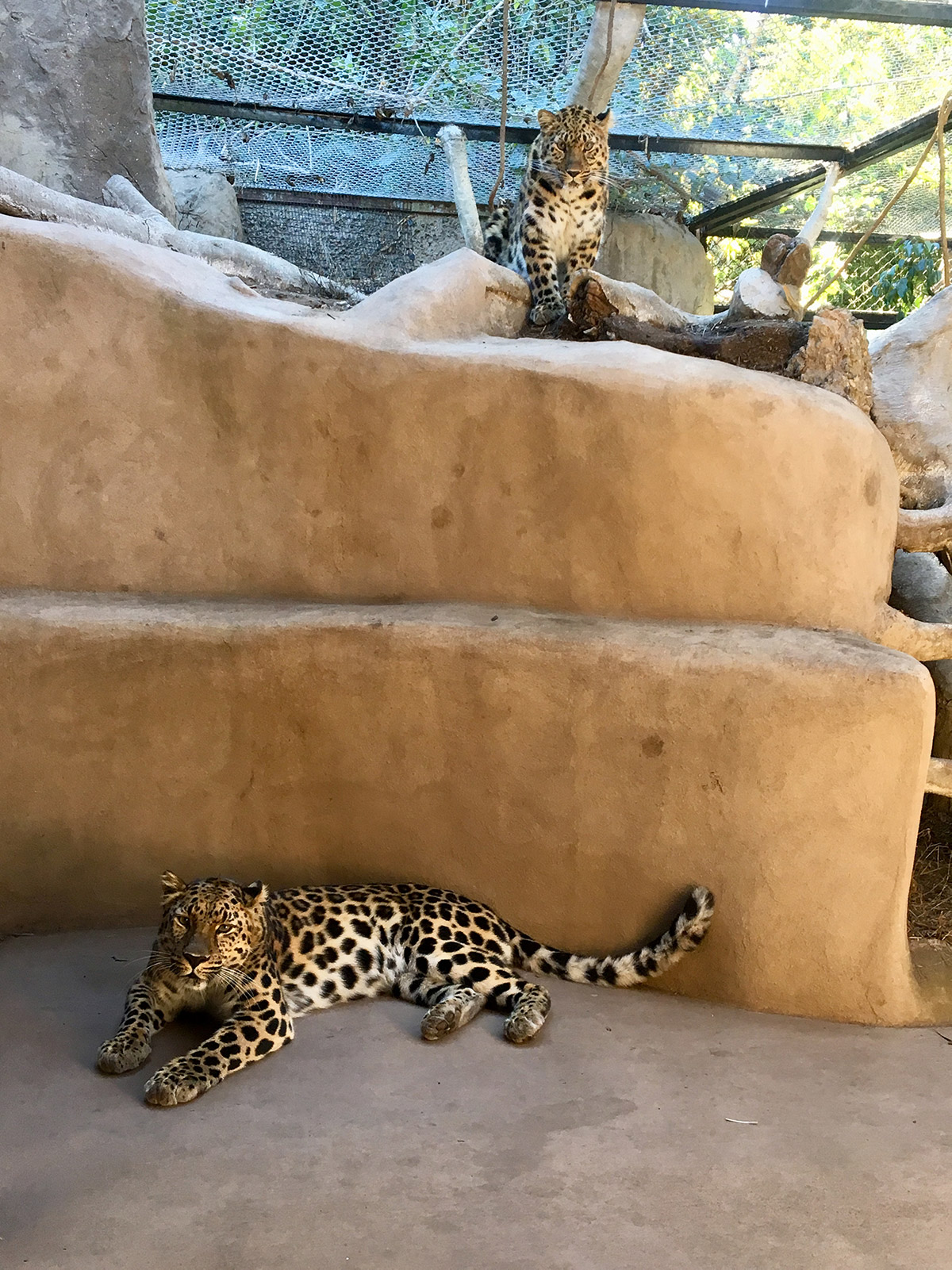
Helping the Amur leopards is a no-brainer for the folks at the Santa Barbara Zoo, as conservation is their heart and soul, according to CEO Block. “I often judge the kind of character of the community by the quality of the zoo,” he said. In 2003, Block helped the S.B. Zoo become a major player in the AZA’s species survival program when he hired Estelle Sandhaus as director of conservation and research. Sandhaus’s responsibilities are expansive, ranging from ensuring critters in her charge are flourishing to overseeing the zoo’s field conservation programs in our region, such as the California condors, the island foxes, and the California red-legged frogs. “We are always looking on the horizon, scanning for threats even to species who are doing okay,” said Sandhaus. “You want to adjust and adapt before you get to rescue.”
Considering the size of our zoo, its scope of participation and success in species conservation is astonishing. “We are in an area that has been identified by both scientists from Conservation International and WWF [World Wildlife Fund] to be really important for biodiversity,” said Sandhaus, “so we have a strong focus on conducting local field conservation initiatives.” As such, the Santa Barbara Zoo has been at the forefront of preservation efforts for myriad endangered fauna in the area, with thrilling results. All of which makes the organization ripe for helping on a worldwide scale.
Reintroduction is a big leap forward for the plight of the Amur leopards, one that couldn’t have been achieved without an international collaboration among conservationists, whose foremost mission it is to keep flora and fauna from going extinct despite their country’s ideology. “I’ve always found that my international conservation colleagues, regardless of their nation, have been so open to work with,” said Sandhaus. “It’s sort of like this language of science and conservation brings people together in a shared goal.”
It’s a worthy objective and one that can take generations to achieve, as the time that is needed to get a species off the endangered list varies. The island fox, for example, was the fastest recovery of any Endangered Species Act‑listed mammal, according to Sandhaus, while the California condor is still in the recovery process after more than 30 years. For the Amur leopards, population stabilization will be a slow process, but the Santa Barbara Zoo is helping on many levels. In addition to financially supporting organizations such as ALTA and participating in the Amur leopard breeding program, the S.B. Zoo is also contributing on the community front. “Education and conservation are the pulse of the institution,” said Block. “If an accredited zoo or aquarium is actively engaged in both, they’ve got a good heart rate. If they’re not, then there is a problem. [Zoos] owe it to the animals under their care to be actively making a difference for wildlife.” Luckily for the Amur leopard, the Santa Barbara Zoo is in it for the long haul.
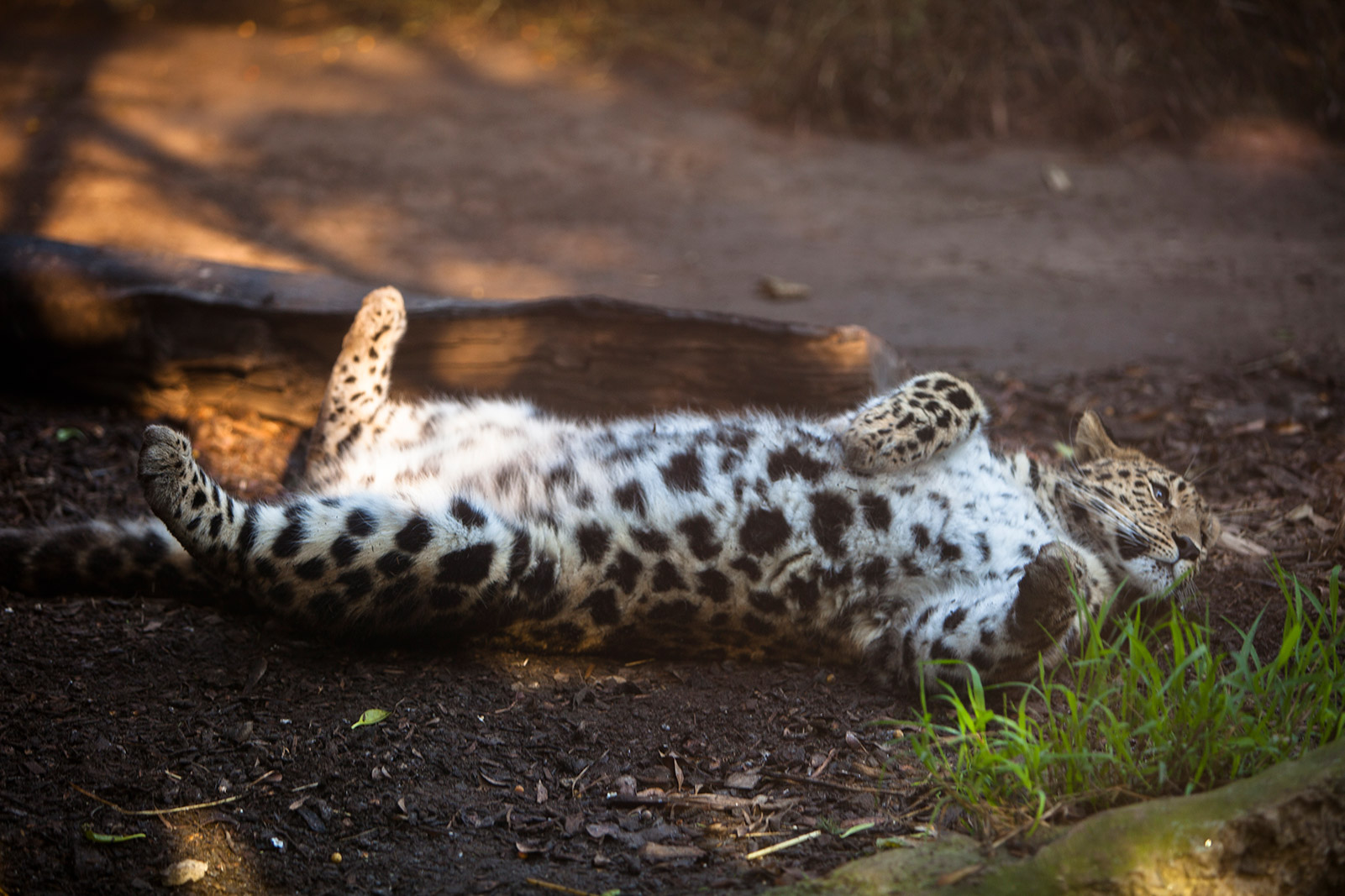
Get to Know Amur Leopards
Habitat: Amur leopards live in temperate forests in far eastern Russia, which has harsh winters with extreme cold and deep snow and hot summers. They have thick fur that grows up to 3 inches long in winter. Their coat is a pale cream color that helps them camouflage in the snow. The Amur leopard’s rosettes (a k a “spots” to the layperson) are widely spaced and larger than those seen on other leopards.
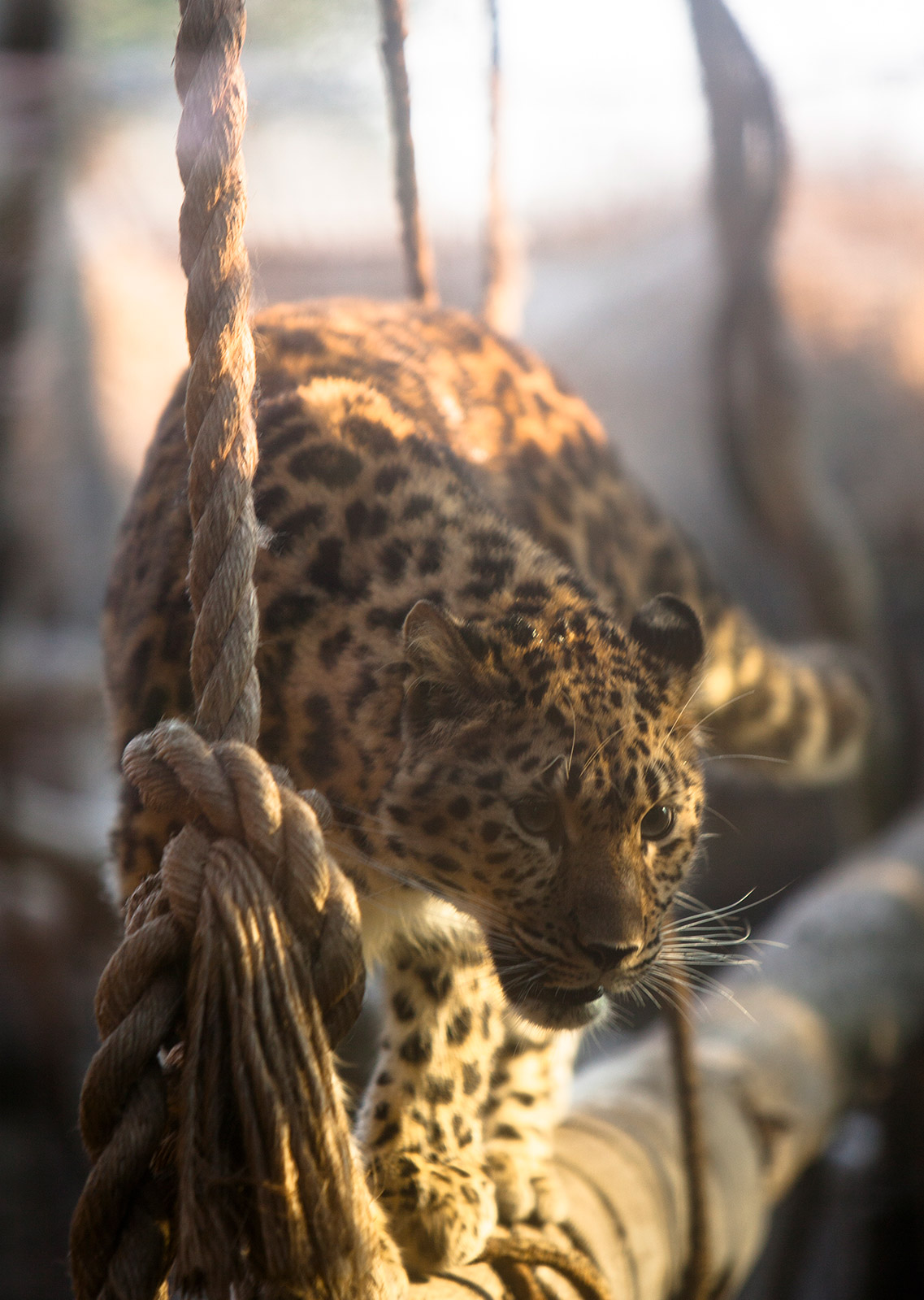
Weight: Males generally weigh 70-105 lbs, but can weigh up to 165 lbs. Females are smaller at 55-95 lbs.
Breeding: Females first breed at an age of 3-4 years. After a gestation period of around 12 weeks, cubs are born in litters of 1-4 individuals, with an average litter size of just over two. The cubs stay with their mother for up to two years before becoming fully independent.
Traits: Amur leopards can jump up to 10 feet vertically and 20 feet horizontally, they can see as far as one mile in the distance, and they make a distinct rasping call rather than a roar.
Lifespan: In the wild, leopards live for 10-15 years; in captivity, they may reach 20 years. Their only predators are Amur tigers and humans.
Prey: Amur leopards hunt a variety of animals including roe deer, sika deer, badgers, and hares. They tend to hunt at night and need large territories to avoid competition for food. They ambush their prey using a burst of speed that can reach 35 mph and then hide unfinished kills, often up trees, so that they are not taken by other predators. They need to eat a large prey, such as deer, about every 15 days.
Source: altaconservation.org/amur-leopard/amur-leopard-factfile
